By Justice Sandra Day O'Connor
Reflections on Arizona’s Judicial Selection Process
January 2, 2008

Other pages in the O'Connor Institute Online Archive mentioned in this article:
| NAME / TITLE | TYPE |
|---|---|
| RonNell A. Jones | Law Clerk |
Article Text
(Excerpt)
REFLECTIONS ON ARIZONA'S JUDICIAL SELECTION PROCESS
Sandra Day O'Connor* & RonNell Andersen Jones**
Using Arizona as a case study, this Essay examines the history of changes in state judicial-selection rationales, methods, and practices. It outlines Arizona's journey from contested elections to a hybrid merit-selection system featuring appointments and retention elections, and compares this experience to that of states that have continued with a pure election system. The Essay explores the purported tension between judicial accountability and judicial independence and argues that Arizona's experience demonstrates both the falsity of that dichotomy and the superiority of a hybrid merit-selection system in simultaneously promoting accountability, independence, competency, and fairness.
INTRODUCTION
This 50th Anniversary Issue of the Arizona Law Review presents a wonderful opportunity to look back at some remarkable legal developments of the latter half of the twentieth century and the issues that have impacted the work of the judicial branch during that time. One important development is a shift in the issues surrounding the judicial selection process. This trend is particularly notable at the state level because selection processes in the states are easier to change, interest has historically been much lower, and more litigation takes place at the state level than in the federal judicial system.1 Judicial selection methods and the practices surrounding them have a great impact
